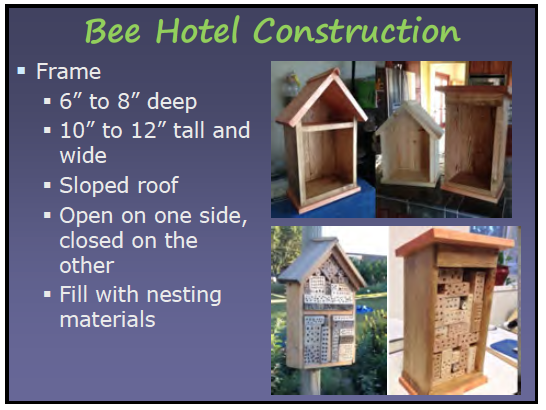The June RCEMG meeting began with an educational program about Bee Hotels by Pam Paulsen.
POLLINATORS
 Drill with a sharp bit and at a high speed as bees avoid rough interiors that could damage their wings
Drill with a sharp bit and at a high speed as bees avoid rough interiors that could damage their wings
Use sandpaper to smooth outside of hole.
Use a pipe cleaner to remove sawdust inside of tunnel.
Pack blocks tightly into frame. Do not glue in.


POLLINATORS
- According to the USDA's Natural Resource Conservation Service, 3/4 of the world's flowering plants and about 35% of the world's food crops depend on animal pollinators to reproduce.
- Worldwide there are close to 20,000 bee species and North America is home to around 4,000 species.
- Approximately 90% fo bees are solitary.
- Most solitary bees are non-aggressive.
- More than 4000 species. Many are solitary.
- Better pollinators and less prone to diseases than imported honey bees.
- 70% ground nesting. To encourage, leave areas of uncovered ground.
- 30% cavity nesting (hollow stems, wood.) To encourage, leave dead wood, build bee hotels. Insect hotels & nest blocks provide nesting sites for solitary bees and wasps and an overwintering site for beetles, bees, wasps, butterflies and moths.
NESTING BLOCK CONSTRUCTION
- Materials: small logs; tree prunings; pine, spruce, oak lumber scraps. Pithy stems: bamboo, Joe-Pye weed, milkweed, sumac, hibiscus, raspberry and blackberry canes.
- Avoid treated wood and fresh cedar.
- Sizes of openings should be varied from 1/16" to 5/8".
- Drill tunnel length 3" to 6" deep. Diameter of hole determines length of tunnel.
- Space holes at least 3/4" apart.
- Never drill entirely through the blocks. The back of the block should be solid.

Use sandpaper to smooth outside of hole.
Use a pipe cleaner to remove sawdust inside of tunnel.
Pack blocks tightly into frame. Do not glue in.
Can protect outside with 1 to 2 coats of Danish Oil (allow several days for odor to dissipate before installing.)
Paint around holes with purple, blue, black or yellow to help bees identify their nest.
Paint the frame to attract bees: bright blue or purple (bees don't see red.)
Use wire mesh to cover front to deter predators.
BEE HOTEL INSTALLATION
- It is best to install a hotel in mid-April for early emerging bees.
- Face the opening to the east or southeast to protect from afternoon sun.
- Place on east side of atall object or building to protect from the hot afternoon sun.
- Place 3' to 5' off the gournd.
- Secure the bee block so it doesn't move in the wind.
- Clear any vegetation blocking the front of the hotel.
- Have pollen and nectar sources (flowers) nearby.
BEE HOTEL MAINTENANCE
- Just before first hard freeze, remove the blocks from the frame and move to more protected areas outside to protect them rodents, woodpeckers and other predators.
- Move back to the frame when first flowers start to bloom.
- Place new, unused blocks out at the same time for newly emerged bees to use for nests.
- Once old blocks are vacated, revove and discard or clean and save for next year.
- Clean the blocks yearly with a 50% bleach/water mixture.
- Every 2 years replace reeds/stems or blocks that can't be cleaned.
- Paper straws can be used to line holes, then replaced every year.







Comments
Post a Comment